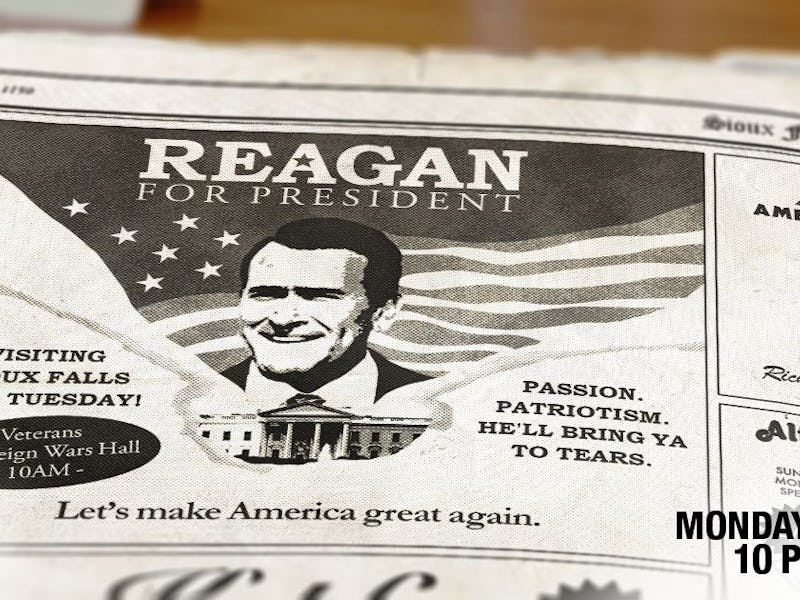All the Ronald Reagan Movies in Last Night's 'Fargo'
Bruce Campbell's turn in 'Fargo' last night brought up memories from Reagan's long movie career.

Last night’s Fargo introduced legendary Evil Dead and Crimewave star Bruce Campbell as a convincing ex-Governor Ronald Reagan, passing through Minnesota on his 1979 campaign trail. Campbell plays the role cartoonishly, but not too much more than the man himself.
In addition to structuring the episode around clips of campaign speeches — the text of which is quite similar to his November 13th announcement of candidacy one — the movie made a few references to Reagan’s acting career, taking pains to remind us that at this time, he was still remembered by much of the country for his acting, as much as his tenure in California government.
We don’t hear much about Reagan’s movies, or even have many ways to see them. Even Turner Classic Movies doesn’t circulate them much. However, in the ‘40s and ‘50s, he was a household name. Here’s a look at the movies that were mentioned — and took on some significance — in Fargo’s plot last night.
‘Bedtime for Bonzo’ (1951)
There is, of course, a reference to Reagan’s most popular and notorious film in the episode. “I’m not shaking his hand,” Nick Offerman’s character, garage owner Karl Weathers, declares as Reagan leaves the hall in Luverne where he has been speaking. When asked why: “Because sonny, he made a movie with a monkey. It wouldn’t be dignified.”
Weathers is referring to Reagan’s cold-fish performance in 1951’s Bedtime for Bonzo, a Bringing Up Baby-like knockoff in which Reagan plays an animal psychologist who tries to teach family values and other important subjective things to a mischievous chimp. How does he do this? Raises him as his child, providing him with a feigned, wholesome nuclear-family backdrop.
Pretty Reagan-esque stuff, when you think about it.
However, the future President didn’t enjoy the chimp-heavy process of the film — refusing to return for the following year’s Bonzo Goes to College — and apparently didn’t even see the film until 1984. By this point, it would have been mocked heavily by anti-Reaganites across the globe.
‘Cattle Queen of Montana’ (1954)
When Weathers — a few seconds after his derisive comment — actually does shake Reagan’s hand, he compliments the former governor on his performance in Cattle Queen of Montana. “Well thank you,” Campbell’s Reagan says, stone-facedly. “Not many people like that film.”
The movie starred Reagan — as an undercover government agent posing as a nimble hired gun — alongside the normally brilliant Barbara Stanwyck as a free-spirited heiress. Cattle Queen is a pretty generic, cowboys-and-Indians Western, with some ludicrous scenes of Stanwyck being taken care of by a Blackfoot tribe. Reagan’s typically wooden performance in the film was widely criticized.
‘Operation Eagle’s Nest’ (1942) — Fictional
In the episode’s funniest and oddest scene, Reagan and Officer Solverson (Patrick Wilson) trade war stories in the bathroom of the hall where Reagan is speaking. After Solverson reveals he did “two tours” on the Mekong Delta, Reagan — tone-deafly — launches into a summary of the WWII movie he made in 1942. He talks as if he was engaged in real combat: “That Nazi bastard had us cornered, but in the end, with a little American ingenuity…” In the end, though, he can’t remember whether the characters actually “made it out of that one.”
Reagan views America’s ability to prevail against all odds in the idealized way of near-propaganda Hollywood epics: One of the episode’s speech clips features Reagan claims that America has done more than any other society to advance mankind. “Operation Eagle’s Nest” is not a real film: The closest he came was co-starring next to Errol Flynn in Desperate Journey, a film about the Allied airmen, that same year. Reagan worked with so-called Operation Eagle’s Nest co-star Laraine Day in a Western in 1941, and James “Jimmy” Whitmore starred alongside the future Nancy Reagan in 1950’s religious fantasy film The Next Voice You Hear…
The fake movie is a weird, but perfectly suitable fabrication. In Fargo’s script, it serves as a symbol of Reagan’s half-baked ideology, a composite of the artless wartime flicks with which he was involved, and a sign of the future bleakness of his presidency. Needless to say, Reagan’s story doesn’t do much for the quizzical Solverson.
Campbell does wonderfully as an earnest but slightly sinister Reagan. Here’s hoping we see more of him in episodes to come.